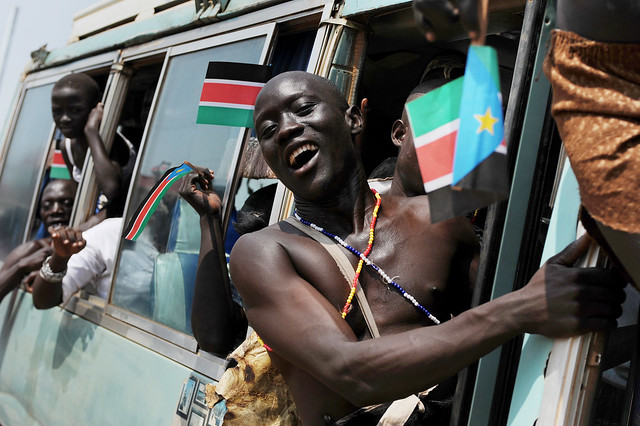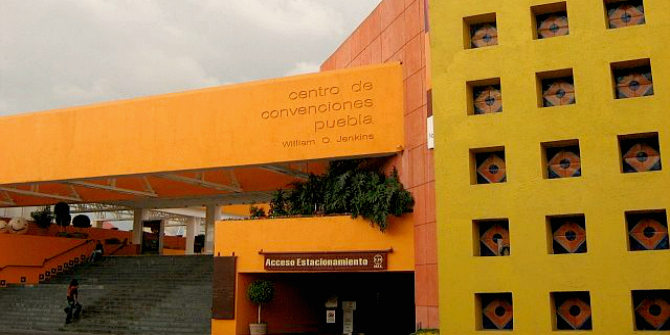James Copnall was the BBC Sudan correspondent from 2009-12, and in this book he aims to diagnose the political failings that threaten the future of both countries. Benefiting from access to the politicians, rebels, thinkers and events that are shaping the Sudans, Copnall draws a compelling portrait of two misunderstood countries. Marisa McCrone finds the book’s informed critique serves as an essential guide for those seeking to understand the complexities and causes of the crises.
 A Poisonous Thorn in Our Hearts: Sudan and South Sudan’s Bitter and Incomplete Divorce. James Copnall. Hurst. 2014.
A Poisonous Thorn in Our Hearts: Sudan and South Sudan’s Bitter and Incomplete Divorce. James Copnall. Hurst. 2014.
“Celebrating the Birth of the New Nation. 9th July 2011” was the cheerful slogan written across the back of a t-shirt worn by a South Sudanese man one month after his country jubilantly declared independence from Sudan, splitting Africa’s largest country into two separate states after nearly 60 years of continuous conflict and two long civil wars. What we are told about this man in James Copnall’s timely new book A Poisonous Thorn in Our Hearts: Sudan and South Sudan’s Bitter and Incomplete Divorce, which documents the recent years following South Sudan’s separation from Sudan,is that he wears the happy shirt while impoverished, waiting in a line for food handouts and a blanket several days after a massacre took place in his town that left more than 600 dead, 200 children abducted, and 25,000 cattle — a prized commodity in South Sudan’s largely agrarian and pastoralist communities — stolen. The bitter irony of this scene is one that is often repeated due to internal conflicts that have increased in frequency since 2011 throughout South Sudan, as independence has not granted a reprieve to the new country’s population from ongoing civil war, hunger, economic instability, and political turmoil.
Current UN figures reflect the staggering statistics of the current crisis in South Sudan: 10,000 people have died since the civil war broke out in December between factions loyal to the president, Salva Kiir, and those backing the former vice president, Riek Machar; 3.5 million is the estimated number of people facing severe food shortages in the coming months; and more than 1 million people remain displaced, while its government run by a former rebel movement and opponents of Khartoum, the Sudan People’s Liberation Movement/Army (SPLM/A), has spent nearly $1 billion on the military, arms, and weapons to quell rebellions, according to SIPRI. How did the cheers that rang through the streets of South Sudan in July 2011 in celebration of its birth turn into cries mourning the thousands who have perished since then, with many more now facing a looming famine?
Copnall, a BBC correspondent in Sudan and South Sudan from 2009–2012, provides some answers and insight into the two countries’ current crises through an exhaustive account that chronicles their respective trajectories leading up to separation and in the years following. Rather than portraying Sudanese and South Sudanese politics with the media’s commonly used simplistic binary narrative of “brave freedom fighters in the south battling to separate themselves from an evil regime in Khartoum”, this book’s strength lies in parsing out in detailed chapters a nuanced portrait outlining the complex reasons behind South Sudan’s independence and the post-independence political, economic, and social ties between the two states that continue to bind them after their divorce.
Built from hundreds of conversations and interviews with Sudanese and South Sudanese people, the book provides an evenhanded account of both countries, with the first few chapters individually addressing the people, politics, and the economies constituting each. The book’s analysis shows how despite a new border, the countries remain politically and economically interdependent, with Sudan coping with the effects of South Sudan’s secession and subsequent loss of its oil revenue along with it, and South Sudan now facing not just state-building but also a nation-building challenge. As Copnall writes, “South Sudan is a state in search of a nation”, as it had often been narrowly defined previously in opposition to Khartoum. The book’s description of both countries notes how each comprises numerous ethnic groups, many of whom reside in both, and whose divisions have been politicized, helping those in power to stay in power. Similarly, single-party politics dominate each country, with the SPLM governing South Sudan and the National Congress Party (NCP) governing Sudan and headed by Omar al Bashir, who has been indicted by the International Criminal Court for alleged genocide, war crimes, and crimes against humanity for the long-running crisis in Darfur. The SPLM and NCP accuse each other of backing ethnically based rebellions and militias in their respective countries.

Bound up with these political parallels is a mutual economic dependence. The book highlights the tangible lines of connection, namely a major oil pipeline running through both their lands that serves as a physical reminder of one of the many triggers of division. After South Sudan ran up its new flag, Sudan lost three-quarters of its billion-dollar oil production to the new country. As in a true divorce settlement, Sudan demanded its alimony payments, and did so by confiscating South Sudan’s oil after failure to agree on the transit fees South Sudan owed it for use of the pipeline. This led to South Sudan taking the drastic step of shutting down the pipeline in 2012, a self-destructive move that further devastated South Sudan’s economy in which oil accounted for 98 percent of its revenue, the so-called “oil curse.”
Such illustrations of economic dependency and kleptocracy are met with calls to diversify the countries’ economies, and the book dedicates an entire chapter to exploring the main reasons for the poverty and underdevelopment that characterize both countries. The three main reasons Copnall identifies are widespread corruption, bloated spending on the military-security apparatus, and the concentration of power and resources in the center at the expense of those on the periphery. This limited access to the state’s resources for selected elites has led to rebellions in the marginalized peripheries that are inflamed by the politicization and polarization of inter-ethnic tension. He identifies the need for “creating institutions strong enough to overcome the ethnic fractures and a deeply militarised society.”
The economic crimes of similar neo-patrimonial systems of governance in both countries and the resultant internal atrocities mirror the inter-related nature between each country’s cross-border violations and the other’s reactionary hostilities unleashed in retaliation. Such issues are the focus of the second half of the book, with individual chapters addressing the two countries’ inter-relations with each other, their internal relations and insecurity, and their relations with countries around the world. The chapters document two new internal Sudanese civil wars in the Blue Nile and South Kordofan states that threaten the stability of Sudan, as well as the continued border dispute in the contested oil-rich Abyei region between the two countries. Also addressed are South Sudan’s own human rights abuses during the disarmament campaign in Jonglei state, an area that has been affected by decades of conflict, and a war in the Heglig oil region. The domestic instability in both countries, in turn, hinders their foreign relations. Copnall describes how South Sudan believes its internal security is dependent on Sudan’s intentions. He cites the former US Special Envoy for Sudan and South Sudan, who stated that each country believes “that the other is the biggest threat, whereas the greatest challenges are actually internal: governing a diverse country, in Sudan’s case, and building a state up from nothing, for South Sudan.”
A key theme throughout the book is the argument that the exclusion of those on the periphery of society from those in the center core is one of the main ills afflicting the development and stability in both Sudan and South Sudan. Structurally mimicking what the two “Sudans” must do to achieve peace, the book offers an inclusive conversation between the voices of those in the center and those lying on the periphery: among his list of interviewees are not only the elite and members of the NCP and SPLM, government minsters, economists, rebels, opposition politicians, and ambassadors, but interspersed throughout are also the often unheard voices of the average Sudanese and South Sudanese civilians — including farmers, teachers, cattle owners, clerics, and tea ladies.
This journalistic style of the book is both its strength and its weakness. Journalist-turned-author Copnall solidly presents the facts and reports on the situations confronting the two states, offering editorials throughout, but does so with chapters that sometimes feel more like encyclopedic entries meticulously detailing the specifics. Despite this, the comprehensiveness and thorough extent of the intricately researched information ensures the reader does not walk away without a complete picture of the various groups, political maneuvering, rebellions, shifting alliances, cross-border issues, key events, economic issues, and disputed territory behind the current hostilities.
The book’s informed critique serves as an essential guide for those seeking to understand the complexities and causes of the crises. As the book indicates, addressing these causes of separation is needed to ensure that Sudan and South Sudan harness the strengths of their mutual dependence in their struggle to create two viable separate states, and in the process, bring a cessation to the violence against both Sudanese and South Sudanese, or otherwise risk seeing the once proudly worn t-shirts celebrating independence become the shrouds cloaking the dead.
Marisa McCrone is an editor at the International Peace Institute. She holds an MSc in International Relations from the London School of Economics and Political Science.







